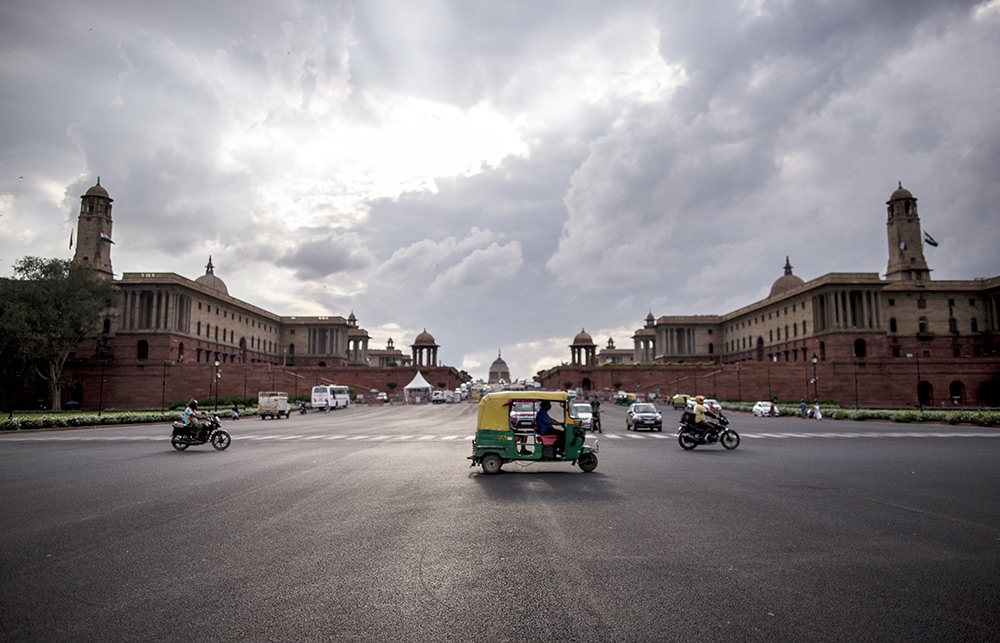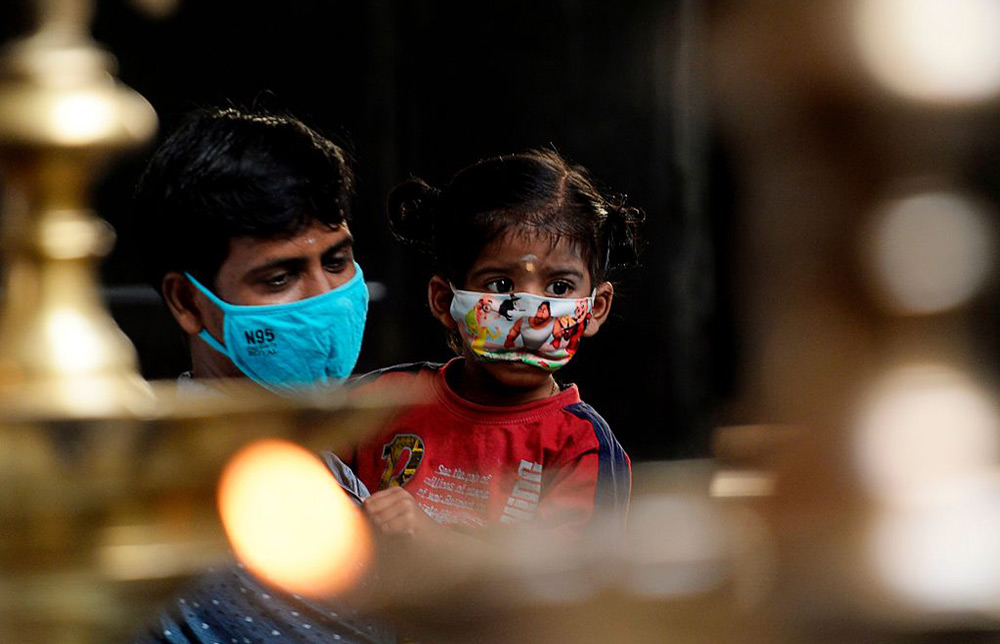印度疫情控制不住,经济也不行了
今年3月下旬,印度总理纳伦德拉·莫迪宣布全国封锁21天,以期阻止新冠病毒在13亿人口中传播。那是世界上最严厉的全国封锁措施:政府命令居民居家避疫,暂停运输网络,并关闭几乎所有企业、办公楼和宗教场所。
印度的封国抗疫举措代表了世界范围内各国政府与公民之间达成的社会契约:为减缓新冠疫情传播、寻求公共卫生利益而做出短期经济牺牲。
但这种牺牲并未换来目标的达成。
实际上,与其他国家相比,印度如今正承受着严重得多的双重打击:印度经济正在经历着该国自1996年开始公布国内生产总值(GDP)数据以来最为严重的衰退,同时它是全球新冠肺炎确诊病例增长最快的国家。
“非同寻常的经济萎缩”
印度政府在8月31日公布,2020年第二季度,该国GDP较去年同期下跌近24%。这是数十年来印度经济最大一次收缩,也创下全球前五大经济体中最严重的第二季度滑坡。(美国经济在第二季度下跌9.5%。)
印度农业产值在第二季度同比增长3.4%,但除此之外,其他行业均形势惨淡。建筑业产值同比下跌50%,制造业下跌39%,贸易、酒店和其他服务业产值下跌47%。
在疫情爆发之前,受累于信贷增长放缓,2018年还是全球增速最快的印度经济已经开始走弱。新冠病毒大流行更是加剧了印度经济的下行。
新加坡国立大学南亚研究学所的高级研究员阿米滕杜·帕利特说:“即使与深受新冠大流行影响的其他国家相比,印度经济萎缩的程度也是非同寻常的。”
封锁与开放
鉴于印度全国进入封锁状态,一定程度上的经济困难肯定是预料得到的,但印度施加抗疫出行限制,反而一定程度上促使了疫情的扩散,并使任何经济反弹复杂化。
莫迪于3月24日晚上8点宣布封国,且封锁令于当晚12点生效,也就是电视通告发布仅4小时后。

混乱随之而来,数十万计的农民工突然被困在他们务工的城市,失去了任何收入来源,也无处就地避疫。许多人徒步跋涉回到了数百英里外的农村老家,从而促使了新冠病毒在全国的传播。
大范围的失业和经济损失迫使印度政府在6月开始分阶段逐步放松封锁措施,尽管印度的新增确诊病例还在上升。
大约两个月后,全国各地的公共卫生系统都因为新冠病毒患者激增而应接不暇。由于需求者不计其数,新冠病毒测试服务处于稀缺状态。国家层面没有要求佩戴口罩的硬性规定;实际上,印度卫生部只建议有明显新冠病毒症状的患者或照顾可能患有该疾病的人时才需要戴口罩。
印度的官方新冠病毒确诊病例总数为369万,仅次于美国和巴西;印度新冠病毒致死病例为65,000人。但在浦那、孟买和新德里等城市进行的血清样本调查表明,新冠病毒的传播比官方数据所展示的程度要广泛得多。在一些特别拥挤的地区,多达65%的受访者已经感染过新冠病毒并拥有了抗体。
印度南部班加罗尔市的年轻职员舒博吉特·戈斯说,超市等公共场所的当前状况“一片混乱”,人们拥挤在一起,似乎并不担心新冠病毒的蔓延。他说:“这并不安全。”班加罗尔有850万人口,8月31日新增确诊病例为2821人。
戈斯认为,印度本应该恢复其最初的严厉封锁。现在,即使新增病例在上升,公众已经无法承受再一次封国。
“由于经济原因,我们不得不开放。”他说,“经济变得很糟。人们完全没有因为要开放而恐慌。”
“印度经历了严厉的封锁。”帕利特说,“但是封国的初衷并未实现。”
掌控形势
帕利特说,印度的双重危机——经济疲弱和失控的公共卫生灾难——使政府进退维谷。
今年5月,印度推出了2660亿美元的经济刺激计划,规模相当于印度年度GDP的近10%。但帕利特表示,政府将很难再提供任何额外的救助措施。
他说,由于封国的经济影响,“(政府)创收处于历史最低水平”。

印度还能动用的资源很可能会花在控制疫情上。
帕利特说:“政府需要为新冠疫情管理和疫苗计划投钱。”
复苏前景
帕利特说,政府预计第三季度GDP数据会好转,因为届时经济重启的效果将展现出来。(今年6月,国际货币基金组织(IMF)预计印度经济全年将萎缩4.5%;第一季度印度经济增长3.1%。)
但是,随着疫情的继续传播,任何经济反弹都会是脆弱的。
戈斯说,在新冠病毒大流行期间,他可以为总部设在新德里的一家公司远程工作,但他父亲的境况就没有那么好了。他的父亲在班加罗尔附近设有工厂的一家制造企业工作。在印度解封后,他父亲所在的工厂已经重新开放,但运营非常小心翼翼。
他说:“只要有一个来厂里上班的工人确诊感染新冠病毒,公司就得把相关工厂关停。”(财富中文网)
译者:Feb
今年3月下旬,印度总理纳伦德拉·莫迪宣布全国封锁21天,以期阻止新冠病毒在13亿人口中传播。那是世界上最严厉的全国封锁措施:政府命令居民居家避疫,暂停运输网络,并关闭几乎所有企业、办公楼和宗教场所。
印度的封国抗疫举措代表了世界范围内各国政府与公民之间达成的社会契约:为减缓新冠疫情传播、寻求公共卫生利益而做出短期经济牺牲。
但这种牺牲并未换来目标的达成。
实际上,与其他国家相比,印度如今正承受着严重得多的双重打击:印度经济正在经历着该国自1996年开始公布国内生产总值(GDP)数据以来最为严重的衰退,同时它是全球新冠肺炎确诊病例增长最快的国家。
“非同寻常的经济萎缩”
印度政府在8月31日公布,2020年第二季度,该国GDP较去年同期下跌近24%。这是数十年来印度经济最大一次收缩,也创下全球前五大经济体中最严重的第二季度滑坡。(美国经济在第二季度下跌9.5%。)
印度农业产值在第二季度同比增长3.4%,但除此之外,其他行业均形势惨淡。建筑业产值同比下跌50%,制造业下跌39%,贸易、酒店和其他服务业产值下跌47%。
在疫情爆发之前,受累于信贷增长放缓,2018年还是全球增速最快的印度经济已经开始走弱。新冠病毒大流行更是加剧了印度经济的下行。
新加坡国立大学南亚研究学所的高级研究员阿米滕杜·帕利特说:“即使与深受新冠大流行影响的其他国家相比,印度经济萎缩的程度也是非同寻常的。”
封锁与开放
鉴于印度全国进入封锁状态,一定程度上的经济困难肯定是预料得到的,但印度施加抗疫出行限制,反而一定程度上促使了疫情的扩散,并使任何经济反弹复杂化。
莫迪于3月24日晚上8点宣布封国,且封锁令于当晚12点生效,也就是电视通告发布仅4小时后。
混乱随之而来,数十万计的农民工突然被困在他们务工的城市,失去了任何收入来源,也无处就地避疫。许多人徒步跋涉回到了数百英里外的农村老家,从而促使了新冠病毒在全国的传播。
大范围的失业和经济损失迫使印度政府在6月开始分阶段逐步放松封锁措施,尽管印度的新增确诊病例还在上升。
大约两个月后,全国各地的公共卫生系统都因为新冠病毒患者激增而应接不暇。由于需求者不计其数,新冠病毒测试服务处于稀缺状态。国家层面没有要求佩戴口罩的硬性规定;实际上,印度卫生部只建议有明显新冠病毒症状的患者或照顾可能患有该疾病的人时才需要戴口罩。
印度的官方新冠病毒确诊病例总数为369万,仅次于美国和巴西;印度新冠病毒致死病例为65,000人。但在浦那、孟买和新德里等城市进行的血清样本调查表明,新冠病毒的传播比官方数据所展示的程度要广泛得多。在一些特别拥挤的地区,多达65%的受访者已经感染过新冠病毒并拥有了抗体。
印度南部班加罗尔市的年轻职员舒博吉特·戈斯说,超市等公共场所的当前状况“一片混乱”,人们拥挤在一起,似乎并不担心新冠病毒的蔓延。他说:“这并不安全。”班加罗尔有850万人口,8月31日新增确诊病例为2821人。
戈斯认为,印度本应该恢复其最初的严厉封锁。现在,即使新增病例在上升,公众已经无法承受再一次封国。
“由于经济原因,我们不得不开放。”他说,“经济变得很糟。人们完全没有因为要开放而恐慌。”
“印度经历了严厉的封锁。”帕利特说,“但是封国的初衷并未实现。”
掌控形势
帕利特说,印度的双重危机——经济疲弱和失控的公共卫生灾难——使政府进退维谷。
今年5月,印度推出了2660亿美元的经济刺激计划,规模相当于印度年度GDP的近10%。但帕利特表示,政府将很难再提供任何额外的救助措施。
他说,由于封国的经济影响,“(政府)创收处于历史最低水平”。
印度还能动用的资源很可能会花在控制疫情上。
帕利特说:“政府需要为新冠疫情管理和疫苗计划投钱。”
复苏前景
帕利特说,政府预计第三季度GDP数据会好转,因为届时经济重启的效果将展现出来。(今年6月,国际货币基金组织(IMF)预计印度经济全年将萎缩4.5%;第一季度印度经济增长3.1%。)
但是,随着疫情的继续传播,任何经济反弹都会是脆弱的。
戈斯说,在新冠病毒大流行期间,他可以为总部设在新德里的一家公司远程工作,但他父亲的境况就没有那么好了。他的父亲在班加罗尔附近设有工厂的一家制造企业工作。在印度解封后,他父亲所在的工厂已经重新开放,但运营非常小心翼翼。
他说:“只要有一个来厂里上班的工人确诊感染新冠病毒,公司就得把相关工厂关停。”(财富中文网)
译者:Feb
In late March, India’s Prime Minister, Narendra Modi, declared a nationwide 21-day lockdown to stop the spread of the coronavirus among the population of 1.3 billion. It was one of the strictest in the world, with the government confining people to their homes, suspending transport networks, and closing almost all businesses, offices, and places of worship.
Implicit in India’s lockdown was the social contract that governments and citizens have entered into worldwide: short-term economic sacrifice in exchange for the public health benefit of slowing the spread of COVID-19.
But the tradeoff never materialized.
In fact, India—far more than its peers—is now getting the worst of both worlds. Its economy is experiencing its deepest recession since it started publishing gross domestic product numbers in 1996, and it has the fastest-growing number of coronavirus cases of any country on earth.
“An exceptional contraction”
India’s gross domestic product shrank nearly 24% in the second quarter of 2020 compared with the same period last year, the country revealed August 31. The contraction is the country’s biggest in decades and the worst second-quarter decline among the world’s top five economies. (The U.S. economy, by comparison, shrank 9.5% in the second quarter.)
India’s agricultural sector grew 3.4% in the second quarter, compared with the same period last year, but besides that, the results were grim. The construction industry shrank 50%, manufacturing shrank 39%, and trade, hotels, and other services shrank 47%.
India’s economy—the world’s fastest-growing as recently as 2018—was already weakening, the result of a credit slowdown. The pandemic sent it spiraling.
“This is an exceptional contraction even if you compare it with other countries in the pandemic,” says Amitendu Palit, senior research fellow at the National University of Singapore’s Institute of South Asian Studies.
Locking down and opening up
Some economic hardship was certainly expected, given the nation’s lockdown, but the way in which India imposed its coronavirus restrictions undercut any public health benefit and complicated any rebound.
Modi announced the lockdown at 8 p.m. on March 24, and said the lockdown rules would take effect at midnight, just four hours after the televised announcement.
Chaos ensued, as hundreds of thousands of migrant workers were suddenly stranded in the cities where they worked, bereft of any source of income, with nowhere to shelter in place. Many people trekked on foot back to their home villages hundreds of miles away, contributing to the spread of the coronavirus across the country.
Widespread joblessness and economic damage pushed the government to ease lockdown measures in ongoing phases starting in June, even as India’s caseload ticked up.
Some two months later, public health systems across the country are straining to cope with coronavirus patients. Tests are scarce owing to overwhelming demand. There is no national mask mandate; in fact, the Ministry of Health advises that masks be worn only if a person is sick with COVID-19 symptoms or caring for someone who may have the disease.
India’s official coronavirus case tally stands at 3.69 million—third behind the U.S. and Brazil—with 65,000 reported deaths, though serological surveys in cities like Pune, Mumbai, and New Delhi indicate that the virus is much more widespread than the official numbers show. As many as 65% of surveyed people in some especially crowded areas had antibodies indicating they had contracted and recovered from COVID-19.
Shubhojit Ghose, a young professional in Bangalore, a city of 8.5 million in southern India that logged 2,821 cases on August 31, says the current situation in public places like supermarkets is “a mess,” with people crowding together, seemingly unworried about the spread of the virus. “It’s just not safe,” he said.
In Ghose’s view, India should have eased into its initial lockdown. Now, the public has no tolerance for trying it again, even as cases rise.
“We had to open up because of the economy,” he said. “[It’s] getting really bad. There’s no panic about it at all.”
“India went through a severe lockdown,” said Palit. “But the purpose of that lockdown hasn’t been served.”
Getting things under control
India’s dual crises—a flailing economy and an unchecked public health catastrophe—have left the government with few options, says Palit.
In May, India released a $266 billion stimulus package, worth nearly 10% of the country’s annual GDP. But Palit says it will struggle to offer any additional relief.
“[Government] revenue generation is at an all-time low” owing to the financial impacts of the lockdown, he said.
The resources that India does have will likely be spent on trying to get the pandemic under control.
“The government needs to spend money for COVID-19 management and a vaccine program,” said Palit.
Prospects for recovery
The government is likely expecting better numbers in the third quarter, Palit says, since the period will reflect the economic reopening. (In June, the International Monetary Fund projected the Indian economy to contract 4.5% for the year; its economy grew by 3.1% in the first quarter.)
But any rebound is precarious, as the virus continues to spread.
Ghose says he has been able to work remotely for a company based in New Delhi amid the pandemic, but his father, who works for a manufacturing company with factories near Bangalore, has not fared as well. His father’s plants have reopened after India’s lockdown, but have done so cautiously.
“If there is a single worker that comes to the plant with COVID, [the company] has to shut it down,” he said.













